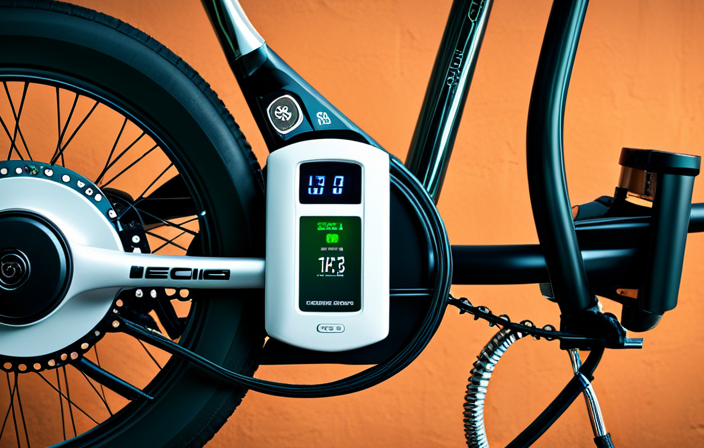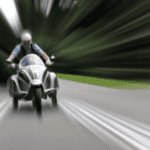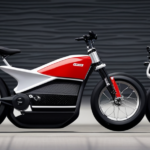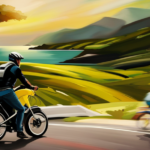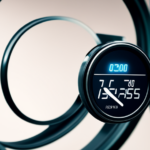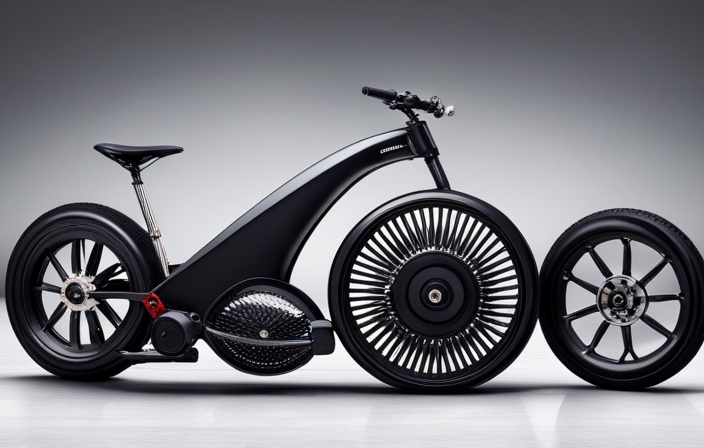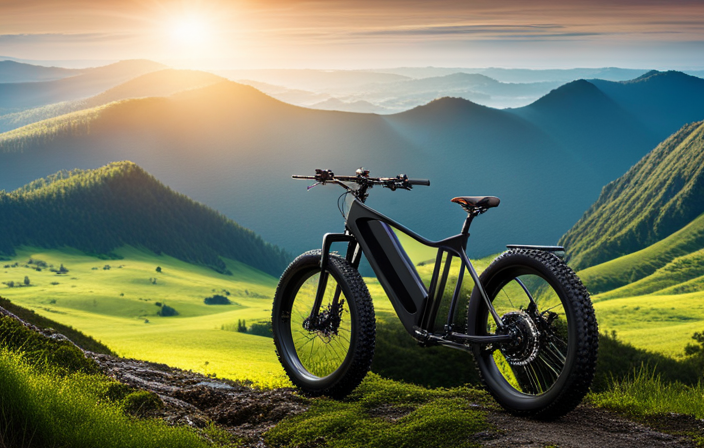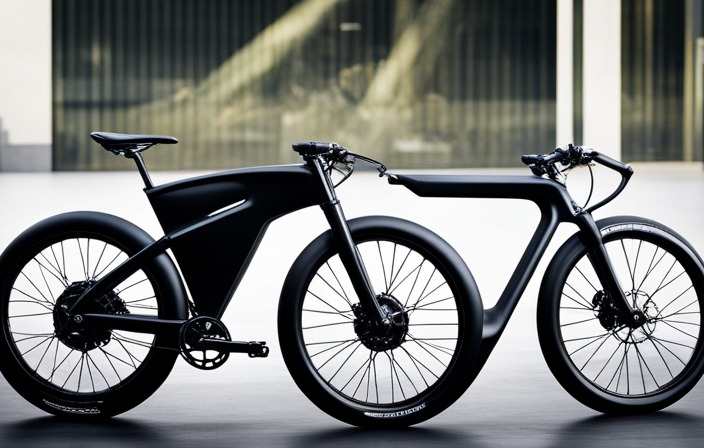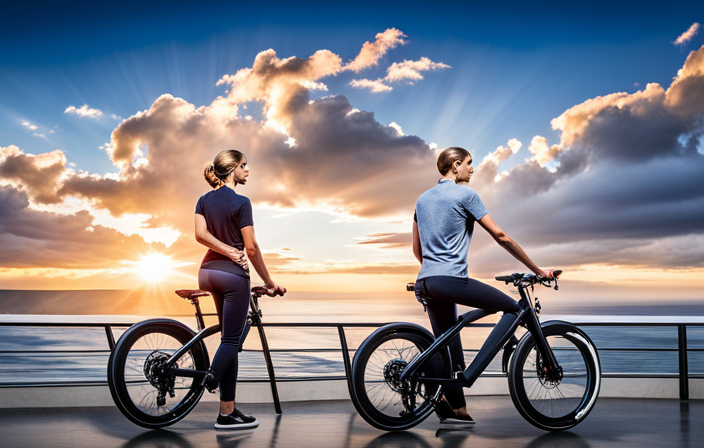Do you ever wonder just how slow an electric bike can go? Well, strap on your helmet and get ready to dive into the world of electric bike speed limits.
In this article, we will explore the factors that determine electric bike speed and the legal restrictions that come into play.
But slow speeds aren’t just about following the rules; they also play a crucial role in ensuring safety on the road.
So, let’s delve into the benefits of riding at a slower pace and discover some helpful tips for mastering the art of slow electric bike speeds.
Key Takeaways
- Electric bike speed limits vary depending on local regulations, with the US federal law limiting speed to 20 mph and Europe typically limiting speed to 25 km/h.
- Factors that determine electric bike speed include battery power, motor type, weight, aerodynamics, and tire pressure.
- Maintaining slower speeds on electric bikes provides better control, reduces the risk of accidents, improves physical fitness, and allows for a greater connection with the environment.
- Electric bike speed can be adjusted and limited through built-in speed limiters and adjusting the pedal assist level.
Understanding Electric Bike Speed Limits
Electric bikes have speed limits that are dictated by local regulations. These speed limits vary depending on the country or region you are in.
For example, in the United States, the federal law limits the speed of electric bikes to 20 mph when the motor is engaged. However, individual states may have their own specific regulations and restrictions.
In Europe, the standard speed limit for electric bikes is typically set at 25 km/h (15.5 mph), although some countries may allow higher speeds.
It’s important to familiarize yourself with the local laws and regulations regarding electric bike speed limits to ensure you are riding within the legal limits. Understanding these regulations is just one of the factors that determine electric bike speed and performance.
Factors That Determine Electric Bike Speed
If you want to increase the speed of your e-bike, factors such as battery power and motor type play a significant role. The battery power determines how much energy is available to the motor, which in turn affects the speed at which the bike can travel. A higher-capacity battery will provide more power and allow for faster speeds. Similarly, the type of motor used in the e-bike can greatly impact its speed. A more powerful motor will generate more torque, enabling the bike to accelerate faster and reach higher speeds.
Additionally, factors like weight, aerodynamics, and tire pressure can also influence the speed of an electric bike. By optimizing these factors, you can enhance the overall speed and performance of your e-bike.
When it comes to legal restrictions on electric bike speed, various countries and regions have different regulations in place. These restrictions typically limit the top speed of electric bikes to ensure safety on the roads. Some areas may have a maximum speed limit of 20 mph (32 km/h), while others may allow higher speeds, such as 28 mph (45 km/h) or even 31 mph (50 km/h).
It’s important to familiarize yourself with the local laws and regulations regarding electric bike speed to ensure that you comply with the legal requirements and ride responsibly.
Legal Restrictions on Electric Bike Speed
Various countries and regions have different regulations in place to restrict the top speed of e-bikes, ensuring safety on the roads.
For example, in Europe, the legal limit for e-bikes is typically set at 25 kilometers per hour (15.5 miles per hour), while in the United States, it varies from state to state, with some allowing e-bikes to reach speeds of up to 28 miles per hour.
These speed restrictions are put in place to prevent accidents and maintain control over the vehicles. By limiting the top speed of e-bikes, authorities aim to reduce the risk of collisions with pedestrians, other cyclists, and motor vehicles, as well as prevent excessive speeding and reckless behavior.
It is essential to recognize the importance of slow speeds for safety on the roads, as it ensures better maneuverability, reaction time, and overall control of the e-bike, promoting a safer environment for all road users.
The Importance of Slow Speeds for Safety
To ensure your safety on the roads, it’s crucial to recognize the significance of maintaining lower speeds while riding your electric bike. Riding at slower speeds allows you to have better control over your bike, making it easier to maneuver and react to unexpected situations. It also reduces the risk of accidents, as you have more time to observe and respond to potential hazards.
Additionally, slower speeds give you a better chance to enjoy your surroundings and appreciate the journey rather than rushing through it. By taking your time and riding at a slower pace, you can fully experience the benefits of electric bike riding, such as improved physical fitness, reduced stress, and a greater connection with the environment.
Benefits of Slow Electric Bike Speeds
When you ride at a leisurely pace, you can fully enjoy the scenery and connect with your surroundings on your electric bike. Riding at a slower speed on your electric bike offers several benefits:
-
Enhanced safety: By riding at a slower speed, you have more time to react to obstacles and unexpected situations, reducing the risk of accidents.
-
Longer battery life: Slow speeds require less power from the battery, allowing you to ride for a longer distance before needing to recharge.
-
Quieter ride: Slower speeds result in less noise, providing a more peaceful and enjoyable experience.
-
Better control: Riding at a slower pace gives you better control over your electric bike, allowing you to navigate turns and corners with ease.
-
Increased comfort: Slow speeds minimize the impact of bumps and vibrations, ensuring a smoother and more comfortable ride.
Transitioning into the subsequent section, it’s important to understand how to adjust and limit the speed of your electric bike to ensure it aligns with your preferences and needs.
How to Adjust and Limit Electric Bike Speed
Adjusting and limiting the speed of your e-bike is a simple process that allows you to customize your riding experience to your liking. Most electric bikes come with a built-in speed limiter that you can easily adjust. The speed limiter controls the maximum speed at which the motor will assist you. By lowering this limit, you can ride at slower speeds and conserve battery power.
To adjust the speed limiter, consult your e-bike’s user manual or contact the manufacturer for specific instructions. Additionally, some e-bikes allow you to adjust the level of pedal assist, which determines how much power the motor provides when you pedal. Lowering the pedal assist level can also help you ride at slower speeds.
Now that you know how to adjust and limit your e-bike’s speed, let’s explore some tips for riding at slower speeds without sacrificing comfort or safety.
Tips for Riding at Slower Speeds
When it comes to riding an electric bike at slower speeds, there are several key points to consider.
Firstly, you should understand the difference between using pedal assist and throttle mode. Pedal assist allows you to control the speed by pedaling, while throttle mode allows you to use a hand throttle to control the speed.
Secondly, controlling your speed on uphills and downhills is crucial for a smooth and safe ride. You can adjust the level of assistance or use your brakes to maintain a comfortable speed.
Lastly, practicing safe braking techniques is essential for maintaining control and avoiding accidents. Make sure you know how to apply the brakes properly and gradually to ensure a safe and enjoyable ride.
Using Pedal Assist vs. Throttle Mode
Using pedal assist on an electric bike allows you to easily control your speed and effort. With pedal assist, you can choose the level of assistance you want, whether it’s a gentle boost or a more powerful push. This feature is especially helpful when you want to maintain a slower speed without exerting too much effort.
To give you a better understanding of how pedal assist works, take a look at the table below:
| Level | Speed | Effort |
|---|---|---|
| 1 | Slow | Low |
| 2 | Moderate | Medium |
| 3 | Fast | High |
As you can see, the higher the level of pedal assist, the faster you can go with less effort. This can be particularly useful when riding in hilly terrain or against strong headwinds.
Now, let’s move on to controlling speed on uphills and downhills without abruptly changing gears.
Controlling Speed on Uphills and Downhills
Controlling your speed on uphills and downhills is easier with pedal assist. It allows you to maintain a consistent pace without abruptly changing gears.
When you encounter an uphill slope, engaging the pedal assist will provide you with an extra boost of power. This makes it easier to conquer the incline without exerting too much effort. The pedal assist system senses your pedaling and automatically adjusts the level of assistance based on the intensity of your efforts. As you pedal harder on an uphill, the motor will kick in to provide more power, helping you maintain a steady speed.
On the other hand, when going downhill, the pedal assist system can be adjusted to a lower level or turned off completely. This allows you to enjoy the thrill of a faster descent while still maintaining control.
Transitioning smoothly between uphills and downhills becomes effortless with pedal assist, making your ride more enjoyable and efficient.
Now, let’s delve into practicing safe braking techniques to ensure a safe and smooth ride.
Practicing Safe Braking Techniques
Practicing safe braking techniques is essential for maintaining control and ensuring a smooth ride on your electric bike. When it comes to braking, it’s important to remember a few key points.
First, always apply both brakes evenly to prevent skidding or loss of control. Squeeze the brakes gradually rather than jamming them suddenly, as this can lead to a jolt and potentially throw you off balance. Additionally, keep your weight centered and avoid leaning too far forward or backward while braking.
By following these techniques, you’ll be able to come to a controlled stop without compromising your safety or the longevity of your electric bike’s braking system.
Speaking of longevity, there are several factors that affect electric bike speed over time. These include battery charge level, terrain, wind resistance, and overall maintenance of the bike. By understanding these factors, you can better manage your electric bike’s speed and ensure optimal performance throughout your rides.
Factors That Affect Electric Bike Speed Over Time
To maintain the speed of your electric bike over time, you’ll want to consider factors such as battery life and regular maintenance.
The battery is the heart of your electric bike, so it’s crucial to keep it in good condition. Make sure to charge it fully and avoid overcharging, as this can affect its performance. Additionally, regularly check the battery connections and clean them if necessary.
Another factor that can impact your bike’s speed is the condition of the tires. Ensure that they are properly inflated and have good tread for optimal grip and efficiency.
Lastly, don’t forget about general maintenance like lubricating the chain, checking the brakes, and adjusting the gears. By paying attention to these factors, you can ensure that your electric bike maintains its speed and performance over time.
Now, let’s explore some real-life examples of electric bike speeds.
Real-Life Examples of Electric Bike Speeds
If you’re looking for an efficient way to commute in urban areas, electric bikes are a great option. With their ability to navigate through traffic and easily find parking, they can make your daily commute a breeze.
Additionally, electric bikes are perfect for leisurely rides and sightseeing, allowing you to effortlessly explore your surroundings while enjoying the fresh air and scenery.
And if you’re feeling adventurous, electric bikes are also great for off-road adventures and trails, providing you with the power and versatility to tackle any terrain.
Commuting in Urban Areas
Commuting in urban areas with an electric bike is a convenient and eco-friendly option. With the ability to navigate through traffic and easily find parking, electric bikes have become a popular choice for city dwellers.
The electric motor provides assistance, allowing you to effortlessly cruise through the streets and reach your destination in no time. Plus, you can avoid the hassle of public transportation or the expense of owning a car.
Electric bikes are also more environmentally friendly than traditional modes of transportation, as they produce zero emissions and reduce traffic congestion. So, if you’re looking for a practical and sustainable way to commute in the city, an electric bike is the way to go.
And when you’re not commuting, these bikes are also perfect for leisurely rides and sightseeing adventures.
Leisurely Rides and Sightseeing
When you’re exploring a new city, hopping on an e-bike is a fun and efficient way to see the sights. Electric bikes provide a smooth and comfortable ride, allowing you to effortlessly cover more ground and take in the beauty of your surroundings. Whether you’re cruising along the waterfront or pedaling through picturesque parks, an e-bike allows you to leisurely explore at your own pace.
To give you an idea of the various sights you can enjoy on an e-bike, here is a table showcasing some popular cities and their must-see attractions:
| City | Must-See Attractions |
|---|---|
| Amsterdam | Anne Frank House, Van Gogh Museum, Canals |
| Paris | Eiffel Tower, Louvre Museum, Notre-Dame |
| Barcelona | Sagrada Familia, Park Güell, Gothic Quarter |
| San Francisco | Golden Gate Bridge, Alcatraz, Fisherman’s Wharf |
Off-Road Adventures and Trails
Exploring off-road trails and embarking on adventurous journeys is an exciting way to experience the thrill of e-biking. When you venture off the beaten path, you’ll discover a whole new level of excitement and challenge.
Off-road e-bikes are specifically designed to handle rough terrains, with features like sturdy frames, suspension systems, and knobby tires that provide excellent traction. These bikes are equipped with powerful motors and high-capacity batteries, allowing you to conquer steep climbs and navigate through rugged landscapes with ease.
Whether you’re tackling rocky trails or conquering muddy paths, off-road e-bikes offer the perfect blend of power and performance.
Now, let’s dive into choosing the right electric bike for your speed needs.
Choosing the Right Electric Bike for Your Speed Needs
If you want to find the right electric bike for your speed needs, you should consider factors such as the motor power and maximum speed.
The motor power determines how fast the bike can go, while the maximum speed indicates the top speed it can reach. Electric bikes come with different motor power options, ranging from 250 watts to 750 watts. A higher motor power will provide more speed and acceleration.
Similarly, the maximum speed of an electric bike can vary from 20 mph to 28 mph, depending on the model and regulations in your area.
It’s important to choose an electric bike with a motor power and maximum speed that aligns with your desired speed requirements. So, take the time to evaluate your needs and choose accordingly for a thrilling and enjoyable riding experience.
Conclusion
So there you have it, fellow electric bike enthusiasts. Now that you’ve delved into the world of electric bike speed limits, you’re armed with the knowledge to cruise safely and responsibly.
Remember, slow and steady wins the race, and in this case, slow speeds can ensure your safety on the road. By understanding the factors that affect electric bike speed and following legal restrictions, you can enjoy the benefits of this eco-friendly mode of transportation.
So hop on your electric bike and let the wind gently caress your face as you ride towards a greener future.

